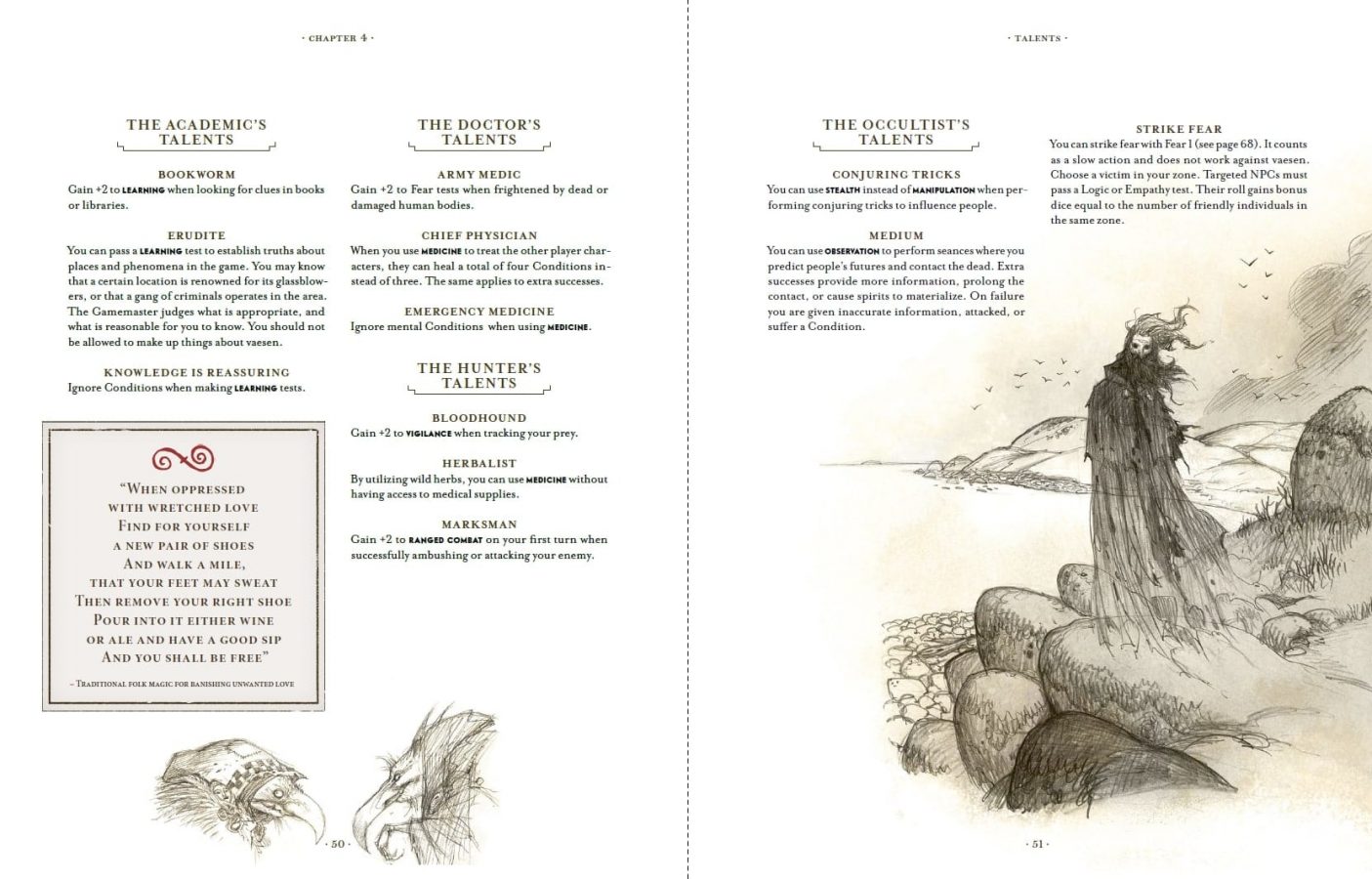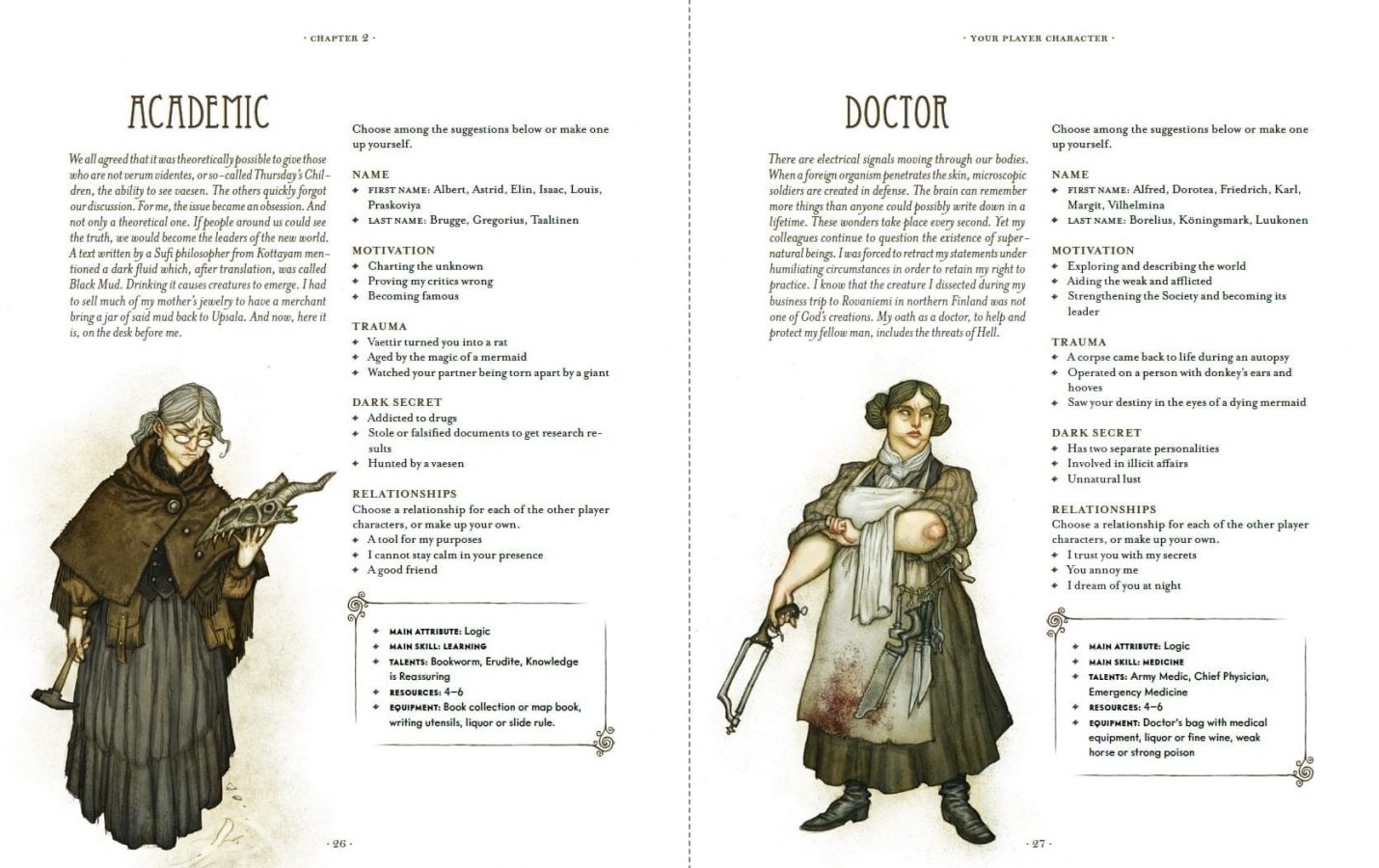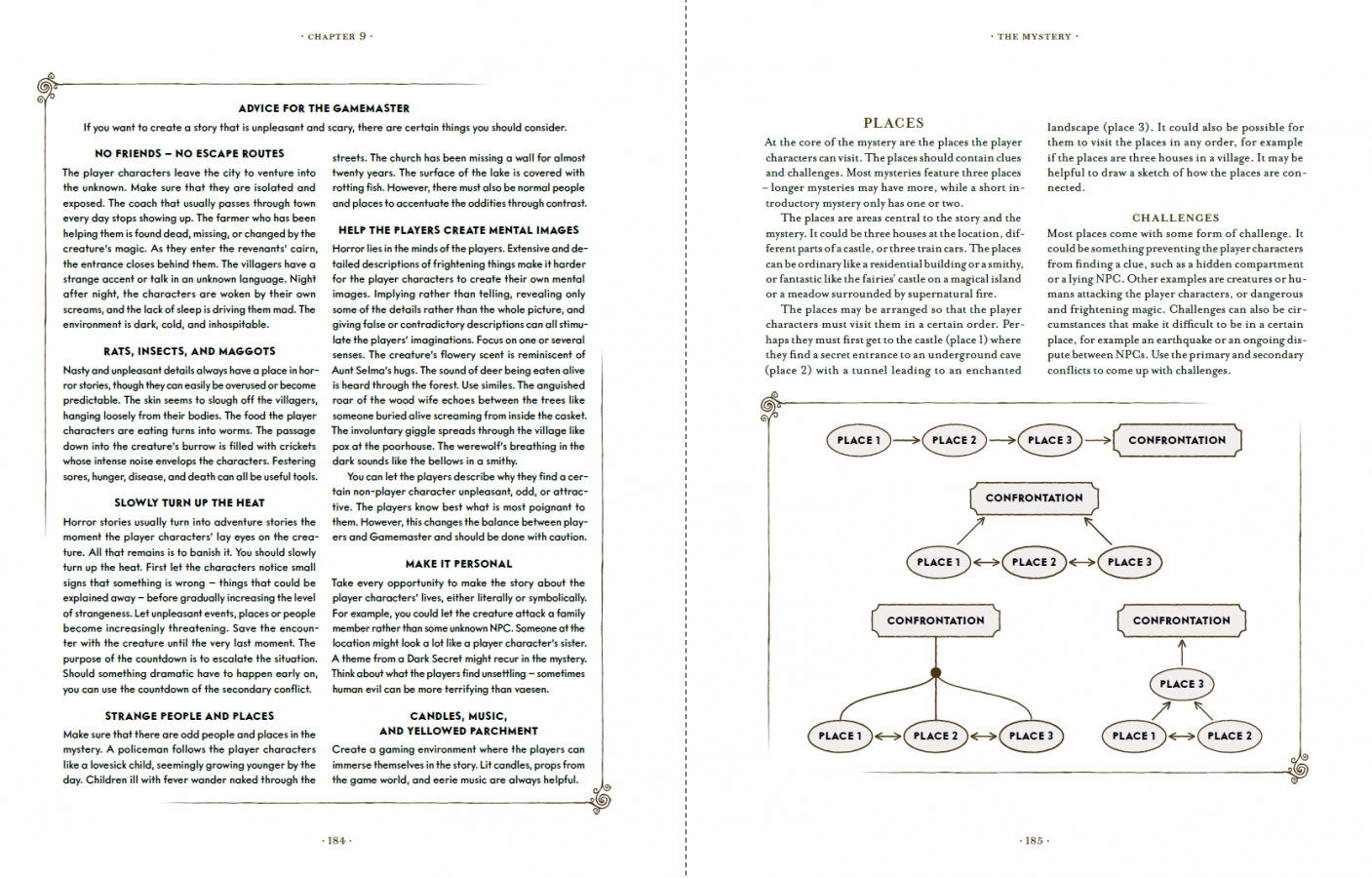
Vaesen’s Nordic Horror experience stands out among myriad monster of the week horror RPGs in almost every way that I value as a reviewer: its aesthetics are strong, its presentation is excellent, its use of source material is thoughtful and unique, and its mechanics, while not quite as developed, help deliver a terrifying yet tragic horror RPG. Add to all of that its base building elements and you see that Vaesen rounds to a rewarding, user friendly delve into foreign folklore and the clash of mysticism versus industrialism.
The game’s titular Vaesen are those supernatural beings that live just off the beaten path, finding their homes in dark forest hollows where man once feared to tread. The game takes place at a turning point in the industrial age, when human expansion forces conflict between ourselves and the Vaesen, but with the emergence of “rational” thought, man has forgotten how to contend with its mystical neighbors. Player characters are members of the Society, an organization dedicated to pacifying the Vaesen, and keeping human society safe from them. Each member of your troupe has access to the Sight, the ability to perceive the supernatural, gained through a past trauma inflicted by unnatural hands. This all takes place in a vision of 1800s Scandinavia that the game wholly admits is not entirely historically accurate. Part pastiche, part reimagining, it suggests that you can, if desired, make use of some more modern concepts about identity when generating characters. There are pros and cons to this approach, but as the result requires so many specifics about the individual table, I leave it up to you as to whether this is a benefit on balance.
There is a compelling tragedy at the heart of this game. Before the encroachment of mankind upon their territory, very few of the Vaesen were hostile, and those that were could be dealt with easily by a savvy traveller. Now, something has been lost as the world wended its way towards “progress.” We no longer know how to deal with the Vaesen appropriately, and their mystery gets mistaken for villainy by an uncanny urban populace. Violence is rarely a solution in Vaesen, and when resorted to it may result in taking something beautiful and unique out of the world which only committed the crime of abiding by its nature. Make no mistake, horror runs deep in this game’s roots, but it’s suffused with the Nordic respect for its mystical counterpart, rather than blind fear of the unknown.

I’ve made no bones before about thinking that Free League releases some of the best game books in the business, and Vaesen is no exception. Its layout is clean and logical, making information easy to learn as you read the book and effortless to reference in game. It’s not only in the technical aspects of monster stats and character rules that Vaesen earns respect for its presentation; the book also contains excellent discussions of how to structure your game from introduction through adventure. Players, as members of the Society, start out with clear relationships and goals, along with a leader and a home base if you want to use that much of the game’s provided setting. The book also delves into advice for how GMs can construct mysteries on a direct, functional game level. Sure, to experienced GMs some of this advice may feel obvious, but scant other RPGs have gone to such efforts to break down the component aspects of investigative storylines; taking its blueprint and one of the Vaesen, you will be well on your way to creating a balanced, satisfying adventure.
The book itself is very high quality; the cover is textured to have an aged feel and the pages are unglossed. On the whole it’s a sturdy volume with a nice ribbon marker included to help you track your page. There may be too much white space in some of the text, but at least that is a deliberate part of the design, meant not to overload you with text and make it easy to locate information in specific areas. A small but much appreciated feature is page 41, wherein the book breaks down the precise math on die rolls and success probability. I don’t know why this isn’t industry standard already, but it’s great to see its inclusion here.
As for dice and their uses, Vaesen uses Free League’s Year Zero engine: players combine attribute and skill values to build a pool of six sided dice to roll. Every 6 is a success, and if you Push a roll, you may choose to reroll all failed dice, but inflicting a negative Condition on yourself.
Along with being a drawback to Pushing rolls, Conditions are the game’s health track. The game contains three physical Conditions (Exhausted, Battered, Wounded) and three mental Conditions (Angry, Frightened, Hopeless). Each Conditions imposes -1 to physical or mental tasks, and if you take three of one type and, should you incur another, you become Broken and are incapacitated until you receive medical attention. You also receive a random critical injury that will injure you in a unique way. Not all of these are strictly bad, and those more likely to be lethal could grant you an advantage. A facial injury could scar you and make you less able to charm others, while becoming possessed could grant unique insights into the natural world.

I’m of two minds about this Condition system, but it’s clear what its goals and benefits are. The pile up of Conditions makes for tension as your characters lose cohesion the longer a mission progresses. Their replacement of a traditional health system also helps enforce the game’s tone of horror: you could get eviscerated, or your character could break down from the stress, or you could choose to flee a situation rather than risk the safety of your broken, traumatized troupe. You find that your characters slowly diminish as the adventure goes on, making the decision to push a hard but sometimes crucial one, whether early for an important roll or later in desperation. With so little protection, combat becomes a rare and careful decision when made.
On the other hand, I wish there were a little more flexibility to this system. Broken and Wounded are, after all, fairly similar, and what if Vaesen could inflict unique Conditions? I would never want it to be as bloated and unwieldy as the Condition system of Onyx Path, but it would help if we had some better ways to differentiate these drawbacks than cumulative penalties. If nothing else, it does keep the game moving quickly, though it means players will only Push rolls for extremely impactful tasks. To its credit, the designers did play around with the Conditions when it comes to Vaesen. They can be inflicted with unique status effects, often requiring knowledge of their particular weaknesses first. That way does impose a lot of variety when it comes to enemy encounters, if not the player experience.
I will freely admit one flaw to this review: I have played this game, but not at a high level yet. Ultimately, and this is to the game’s benefit, the power levels are small across the board. Fear levels, damage amounts, and penalties all flatten out at a certain point. The question becomes what happens when the players have more experience, and can ignore some of those penalties. But I can’t say for sure whether this comes up or not. I can predict it being easy to raise fear levels or vary the experience, but I don’t know how it holds up after a long campaign. Of course, with its quick pace for character and adventures can be ideal for one shots, and how many games practically last long? If this is a deliberative design point in recognition of how short games go, I can’t say that it’s a bad idea.
Character generation is quick and simplistic, but not to an unsatisfying degree. The game doesn’t provide very much in the way of choice, and if you were going to play more than one game I think you would look for a few more options in terms of Talents and Equipment; while the game does not allow for “builds” you do have enough to differentiate your characters from one another. The first thing you will do is choose an Archetype, which, beyond giving you a sense of what kinds of characters are appropriate in this setting, determine your starting resources, equipment, and Talents (similar to feats). Similarly you decide on your Motivation, the Trauma that gave you the Sight, and a Dark Secret, all pure roleplay decisions. Of mechanical importance is your age. Higher age reduces starting attributes but increases starting skill points, making the decision an important one. As you can see, there isn’t much to decide besides archetype, though you will have some decisions to make about where to place attribute and skill points. The game also contains a random generation method if you want something more organic.

Combat is fairly simple as well. You determine initiative by drawing and distributing playing cards from 1 to 10. Every turn you can take a fast action and a slow action, and you can burn a fast action to attempt to block or dodge and attack. Attacks can be physical or mental, as you have Condition tracks for both, and geography is abstracted into Zones of action, in which individual events are taking place. When in combat or otherwise, Vaesen can inflict fear effects, which force you to roll when encountering them or take negative Conditions.
Because of the simplicity of the system, weapons and armor are very limited. The rest of the normal equipment covers all of what you may want, but there isn’t much to differentiate weapons and armor. It would be nice if, like in Coriolis, they had some tags or qualities to help differentiate them, but as this is fundamentally a low power horror game it’s hard to make much of an issue out of it. As with everything else in the game what’s going on under the hood with equipment is well presented, effective to its purpose, but ultimately somewhat limited. Mostly that’s a strict benefit, as it makes for extreme ease of learning, playing, and modifying.
As for setting, you can ignore the Society angle to the game easily, but you would be remiss in doing so. Beyond giving you a clear adventure structure, i.e. the Society says they have some reports and sends you to an area, the game also provides you with mechanics for reviving that organization. You build up your home base, your staff, and your reach across the land. It provides an in-universe philosophical split between approaches to the Vaesen conflicts. Nothing shackles you to this concept, but its benefits are clear. It gives them something to strive for, growing in authority, influence, and knowledge as they safeguard the safety of those without the Sight. Of course, there is also a mechanical aspect to this: as the game progresses, you will gain Development points that you can spend on improving your base and its capabilities. You cannot only gain locations, such as an occult library or workshop, but personnel to help staff the place.

The core book also gives you insight into the Mythic North- a well researched look at the place, its peoples, and its conflicts. More than just set dressing, its beautiful maps are highly useful for gauging distances and population levels. Upsala, the central city, is filled to the brim with story ideas for the players to discover. I would strongly recommend that players not read the setting or Vaesen section at all. Let yourselves explore in game, and your lack of knowledge about the unknown will strictly enhance your experience.
As for the Vaesen themselves, each writeup is a clean two pages of lore, mechanics, and artistic depiction. It’s exactly enough information to give you hooks and interesting depth, but also be able to use completely on the fly. I could improvise a session of this in 15 minutes by doing nothing but reading a Vaesen page and glancing at the Mysteries section.
The stats are limited in power level but universally terrifying. Creatures can be more than physically threatening, thanks to their mysterious and varied powers. To beat them you need to conduct intense research and a variety of skills beyond that of brute force. While some of these are familiar, there will also be some new faces amongst the foes, and twists on those the players think they understand. Magic is not even available to players to start with, and if you so choose its intricacies can forever be kept from human hands. There’s also a great list of sample npcs and random npc traits, if you happen to need a variety of people on the fly.
Rounding everything out is the core book’s sample adventure: The Dance of Dreams. The most important thing about this adventure is that it starts with a step by step summary for you, the GM, to understand the following events. Reading too many professional adventure modules and adventures lands you a giant block of text gobbledegook, which does nothing to help you run the game. Seriously, I don’t know how they keep getting away with it. An adventure that does not induce at least a basic summary of events is a slap in the face. But I digress.
I don’t want to spoil any of its story, but suffice it to say there’s a lot to love about this adventure. It ties in investigation, setting, and horror in a tasteful way, but still grants the game a brooding sense of menace. Players will have to use their wits to investigate this problem, and jumping into it blind very well could kill the party. It also gives you plenty to work this in terms of discreet clues without forcing you down a simple path. It’s also replete with handouts and maps that feel in-universe so you can hand copies out to your players directly.
Vaesen might not be the perfect game, but I can say without reservation its presentation is as close to perfect as we can ask for in an RPG. I was consistently awed at how much care and thought were put into this book’s layout. If you are new to running games and want a hand creating dynamic, adaptive horror adventures, Vaesen is a perfect starting point. Not only does the Nordic aesthetic grant the game a unique tone, it also ramps up the horror by facing players up to unfamiliar quantities, as well as dangerous twists on those that might seem familiar.
If you’re interested in Vaesen but would like some more support, stay tuned for my coverage; next on the docket I will be looking at the Vaesen GM screen and its adventure supplement Wicked Secrets and Other Mysteries.
Vaesen
Excellent
Vaesen sets a new standard for communicating information to the reader. Its Nordic horror presents a tragic yet terrifying world of lost innocence, but ultimately stands as a vision of hope in dark times. New entrants into the hobby should strongly consider this game, though anyone would be well served by experiencing its folklore inspired mysteries.
Pros
- Presentation/layout
- Base building element helps to flesh out and structure your game
- Complex approach to the monsters
Cons
- Overly simplistic in a few areas
- The Conditions system can lead to issues
- Not much to differentiate characters mechanically
